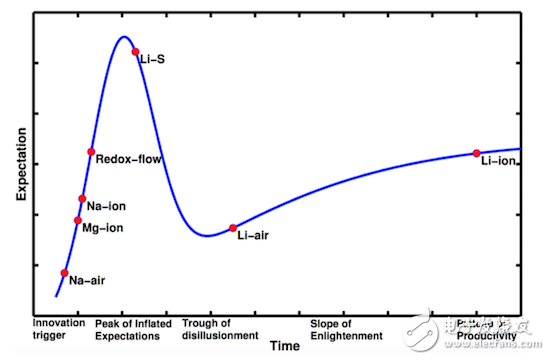The “Technology Growth Curve†proposed by Carnegie Mellon University tells us how far it is for many new technologies to compete with lithium-ion batteries. Every few weeks we can see explosive news, claiming to discover the "Holy Grail" of battery technology. In the future, we can use this technology to fully charge smart phones in a few minutes, drive electric cars for hundreds of miles, and develop cheap and reliable. Renewable energy storage means. However, these "subversive game rules" batteries do not seem to play a role outside the headlines. What is going on here? Venkat Viswanathan, assistant professor at the School of Mechanical Engineering at Carnegie Mellon University, asked the same question. In a recently published paper, he and his colleagues proposed a "hype cycle" that quantifies battery chemistry research. These researchers counted new technical papers on specific battery chemistries to determine the location of the technology in the “technical growth curveâ€: from “innovation starting pointâ€, “expected expansion peak†to the final “stable production periodâ€. This last stage is where the current lithium battery is located. This chart shows some different types of battery technology. Manganese-ion batteries, sodium-ion batteries, and lithium-sulfur batteries work in a similar way to lithium-ion batteries, but they have beaten lithium in terms of energy density (determining how small or light the battery is) and cost. The potential of ion batteries. For example, due to the low price of sulfur, lithium-sulfur batteries have the potential to significantly reduce costs compared to today's lithium-ion batteries. However, the current lithium-sulfur battery is not stable, and it is prone to a significant decrease in energy efficiency and self-discharge. Also, when the ions move in the battery, the electrodes of the lithium-sulfur battery may expand by 80%, so that it is difficult to find a material that maintains the shape of the battery. However, lithium-sulfur batteries are one of the most promising technologies, and their development has just passed the “expected expansion peak†pointed out by Viswanathan and his students. The lithium-air battery is the only battery that has crossed the "bubble burst valley" and goes to the "enlightenment period" except for the lithium-ion battery. The energy storage technology of lithium-air batteries is completely different, and the potential to defeat lithium-ion batteries is enormous. This battery uses metal lithium as a negative electrode and reacts directly with oxygen in the air at the positive electrode end. Since one of the reactants is air, in theory, the battery requires only half of the other cells to store the same energy, and its weight can be halved. This advantage is of particular concern to the electric vehicle industry, as small-volume battery packs are very advantageous for electric vehicles. However, lithium-air batteries have a long way to go before they can achieve a "stable production period" in terms of cost and longevity compared to conventional lithium-ion batteries. The value of Viswanathan research is to help us predict the stage of development of different battery technologies. Although innovative technologies are springing up, lithium-ion batteries are still the winner in portable electronic devices, electric vehicles, and power grid equipment. Perhaps within a few years, we can witness lithium-air batteries surpassing lithium-ion batteries, and the competitiveness of electric vehicles relative to gasoline and diesel vehicles has increased significantly. However, lithium-air batteries are still in the “enlightenment periodâ€, and there is still a long way to go to reach the level of lithium-ion batteries, not to mention competition with fossil fuels. Stainless Steel Sanitary Pipe,Sanitary Pipe Material Stainless Steel Tube,Astm 409 Saintary Stainless Steel Pipe,Ss Seamless Saintary Pipe ShenZhen Haofa Metal Precision Parts Technology Co., Ltd. , https://www.haofametal.com